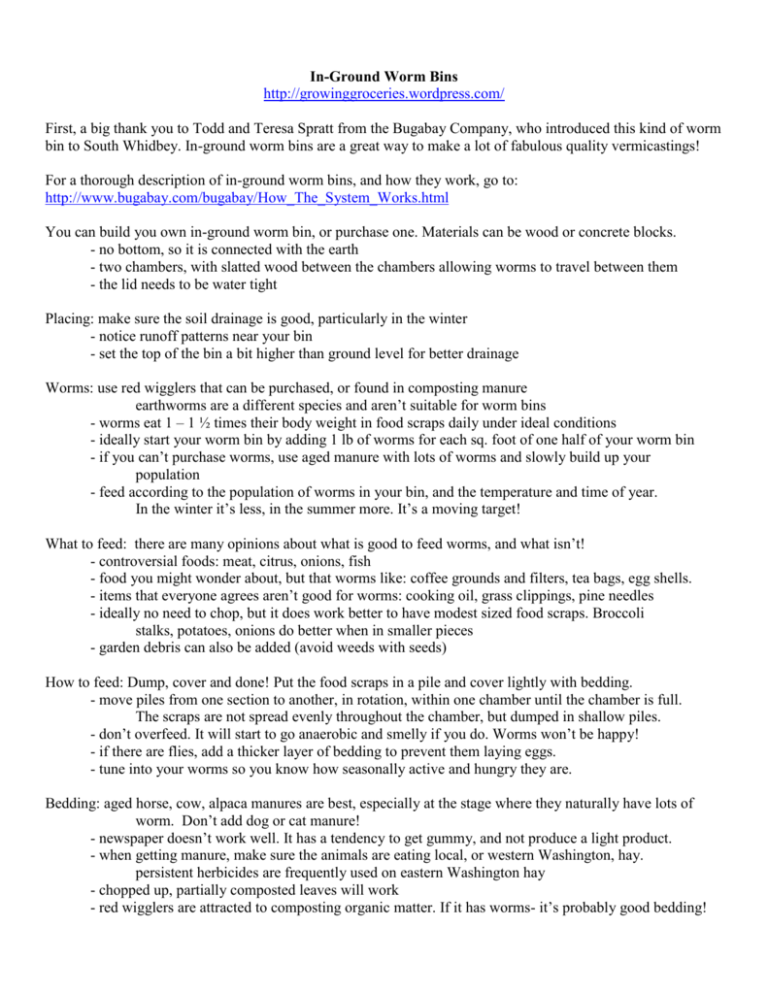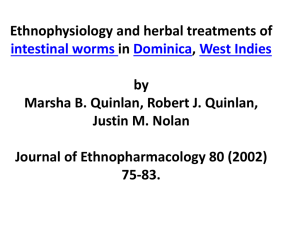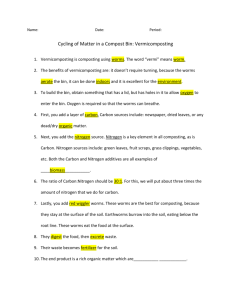In-Ground Worm Bins
advertisement

In-Ground Worm Bins http://growinggroceries.wordpress.com/ First, a big thank you to Todd and Teresa Spratt from the Bugabay Company, who introduced this kind of worm bin to South Whidbey. In-ground worm bins are a great way to make a lot of fabulous quality vermicastings! For a thorough description of in-ground worm bins, and how they work, go to: http://www.bugabay.com/bugabay/How_The_System_Works.html You can build you own in-ground worm bin, or purchase one. Materials can be wood or concrete blocks. - no bottom, so it is connected with the earth - two chambers, with slatted wood between the chambers allowing worms to travel between them - the lid needs to be water tight Placing: make sure the soil drainage is good, particularly in the winter - notice runoff patterns near your bin - set the top of the bin a bit higher than ground level for better drainage Worms: use red wigglers that can be purchased, or found in composting manure earthworms are a different species and aren’t suitable for worm bins - worms eat 1 – 1 ½ times their body weight in food scraps daily under ideal conditions - ideally start your worm bin by adding 1 lb of worms for each sq. foot of one half of your worm bin - if you can’t purchase worms, use aged manure with lots of worms and slowly build up your population - feed according to the population of worms in your bin, and the temperature and time of year. In the winter it’s less, in the summer more. It’s a moving target! What to feed: there are many opinions about what is good to feed worms, and what isn’t! - controversial foods: meat, citrus, onions, fish - food you might wonder about, but that worms like: coffee grounds and filters, tea bags, egg shells. - items that everyone agrees aren’t good for worms: cooking oil, grass clippings, pine needles - ideally no need to chop, but it does work better to have modest sized food scraps. Broccoli stalks, potatoes, onions do better when in smaller pieces - garden debris can also be added (avoid weeds with seeds) How to feed: Dump, cover and done! Put the food scraps in a pile and cover lightly with bedding. - move piles from one section to another, in rotation, within one chamber until the chamber is full. The scraps are not spread evenly throughout the chamber, but dumped in shallow piles. - don’t overfeed. It will start to go anaerobic and smelly if you do. Worms won’t be happy! - if there are flies, add a thicker layer of bedding to prevent them laying eggs. - tune into your worms so you know how seasonally active and hungry they are. Bedding: aged horse, cow, alpaca manures are best, especially at the stage where they naturally have lots of worm. Don’t add dog or cat manure! - newspaper doesn’t work well. It has a tendency to get gummy, and not produce a light product. - when getting manure, make sure the animals are eating local, or western Washington, hay. persistent herbicides are frequently used on eastern Washington hay - chopped up, partially composted leaves will work - red wigglers are attracted to composting organic matter. If it has worms- it’s probably good bedding! In-ground worm bins, pg. 2 Moisture: should be the feeling of a wrung out sponge. - add water if too dry - open lid to dry out and add bedding Harvesting: http://www.bugabay.com/bugabay/How_The_System_Works.html has a good step by step - after one chamber is filled up, let it finish off and start on the other chamber - when the second chamber is almost full, empty the first chamber - work the upper level of the first chamber so the worms move away, and harvest successively deeper levels - leave several inches of castings at the bottom of the chamber, don’t go all the way to bare dirt - pick out the worms and put them in the other chamber. Also look for the worm capsules. - store in breathable polyester or burlap bags. Challenges - overfeeding worm bins in the winter when they slow down - getting too wet in the winter (poor drainage, runoff into bins, or leaky lids) - underfeeding in the spring when the worms become more active - letting the bin get too dry in the summer - overfeeding, or underfeeding, for the amount of worms in the bin worm activity varies seasonally-- keep observing & adjust your feeding schedule as indicated - check the edges for rat activity and fill in any holes. Rats don’t seem to be digging deep enough to get into the bins, but they will explore around the edges. - finding the right bedding. Make friends with horse owners, or purchase aged cow manure at Whidbey Topsoil. Enjoy your learning curve, and also the wonderful vermicastings you’ll produce from your in-ground worm bins! http://growinggroceries.wordpress.com/








